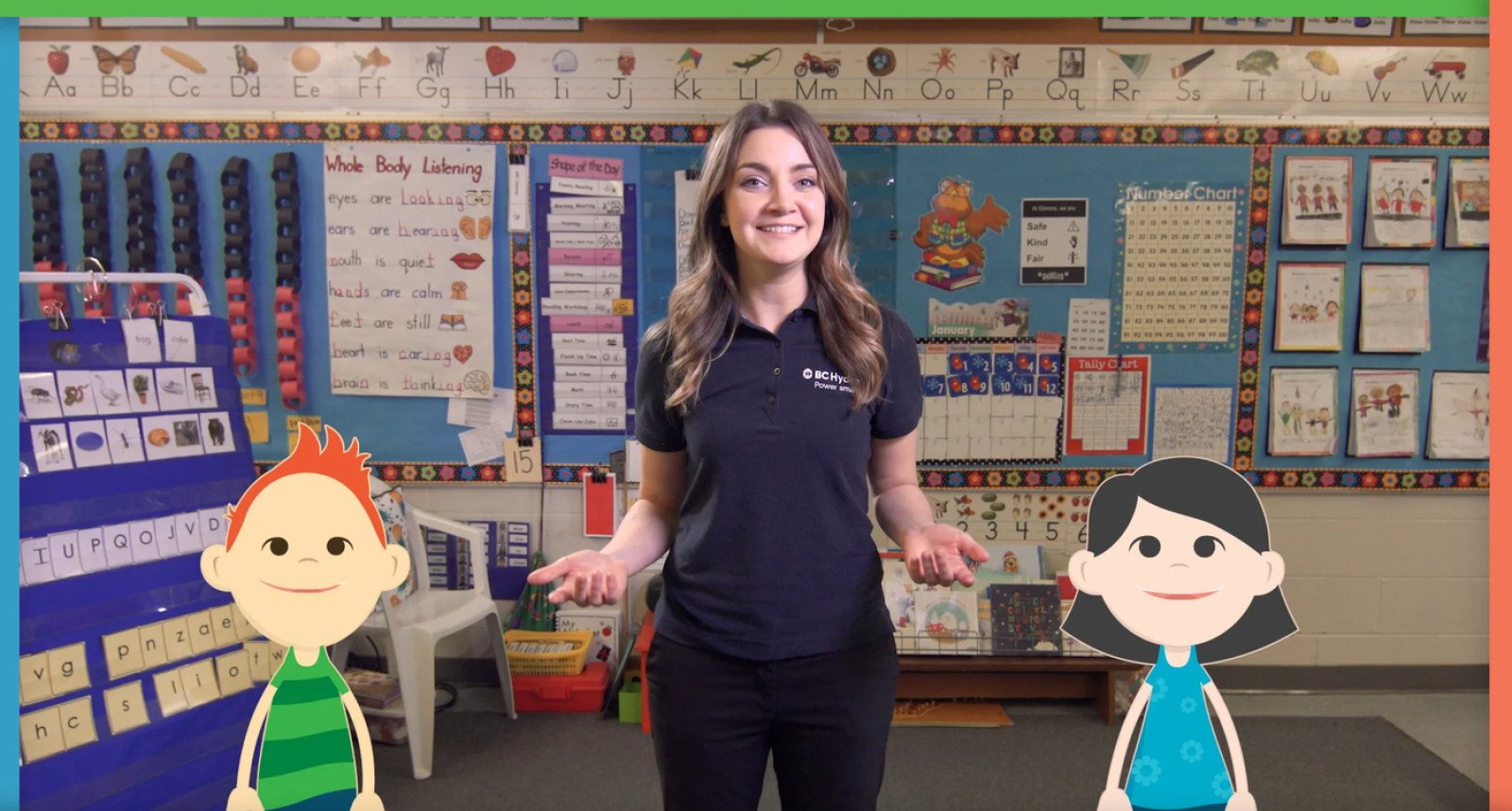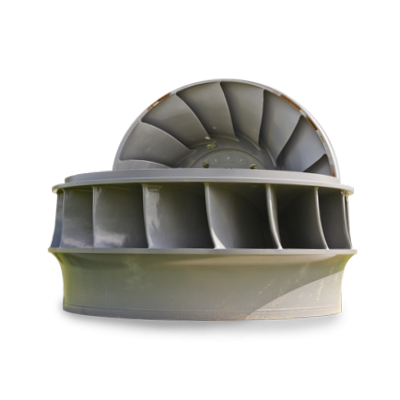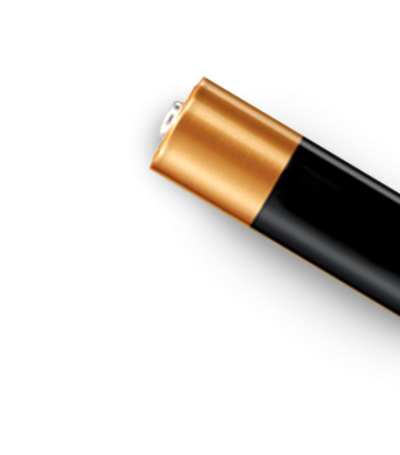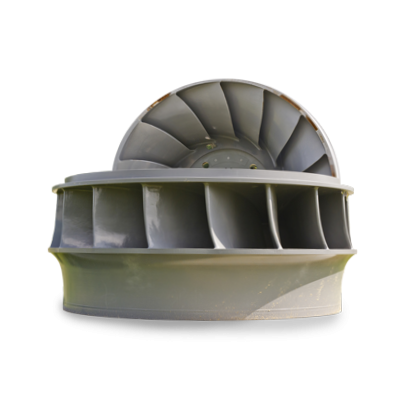Energy stretch
Crash, swish, swirl! Do the energy stretch using actions to show how water generates electricity.

Overview
Learn about ways electricity is used every day, then with sounds and actions, demonstrate the energy stretch and have the class follow along using a fun video. Finally, brainstorm then draw pictures of ways to save electricity.
Instructions
What you'll need
- “Energy stretch teacher instructions video” – watch before activity
- “Energy stretch video” – for use during the activity
- paper, markers, crayons
I spy electricity
- Tell your class they’re going to learn about electricity.
- Explain there are many things that need a special kind of energy, called electricity. We use it every day.
- Find something in the classroom that uses electricity and point it out to the students. Show them the wire connected to the outlet and explain that if you plug something in and can turn it on, it needs electricity to work.
- Have students look for other items in the classroom that use electricity and make a list on the board or on chart paper.
Energy stretch
- We’re going to use actions to show how we use the power of water to make electricity.
- Ask two students to come to the front of the class and play the “Energy stretch video” above. (Optional: watch the instructional video before class to get familiar with all the steps prior to leading it with your students.)
- Using actions from the video, have the class follow along as you demonstrate how water falls from clouds, passes through a dam and spins a giant turbine to generate the electricity we use every day.
Partner up
- Have students practice the different steps in the energy stretch with a partner.
- Invite a pair of students up to the front to demonstrate the energy stretch. Have the class follow along and prompt the students as needed.
- Make a cloud over their heads. This is where rain and snow comes from. Pitter patter.
- Rain and snow fall to earth and make lakes, seas, oceans and rivers. Arms wiggle side to side. Crash, swish, swirl.
- Rivers move along until they reach a dam. Arms in front.
- Water rushes down the pipes to make electricity. Arms swoop up and down. Crash, swish, swirl.
- Water travels through the giant wheels, called turbines, to make electricity. Twirl arms fast.
- Electricity travels on power lines to homes and schools. Send electricity to something that uses it. Ping ping.
Saving electricity
- Now we’ve done the energy stretch and know the electricity we use every day comes from the rain and snow that falls from the clouds.
- Water comes from nature.
- When we use electricity, it affects the earth.
- To take care of the earth, we need to save electricity and use only what we need.
- Ask students what they can do to save electricity. Share ideas.
- See Power Smart ideas at school in the Teaching notes for suggestions.
- Have students use a piece of paper to draw a picture of something they can do to save electricity.
- Have students write, or teacher can transcribe, the actions on the pictures and post them on the class bulletin board to share their ideas with the rest of the school.
Modify or extend this activity
- Students design and create pinwheels to explore how wheels spin to make energy in “Let’s make a pinwheel.”
- Electricity trail
- Go on a search for things that use electricity.
- Use your eyes to observe and find things that use electricity. Look for plugs.
- Help students notice things by using I spy sentence starter.
- Have students draw pictures of things they saw on the trail.
- Make a wall display.
- Have students find things that use electricity in the community and at home. Add ideas to the list of things that use electricity generated in part 1 of the activity.
Curriculum Fit
Science K, 1, 2
Big idea
- Observable patterns and cycles occur in the local sky and landscape (Grade 1)
- Water cycle (Grade 2)
- Water sources (Grade 2)
- Water conservation (Grade 2)
Content
- Local patterns (including clouds and precipitation) that occur on Earth and in the sky (Grade 1)
Curricular competencies
Processing and analyzing data and information
- Experience and interpret local environment
Applying and innovating
- Transfer and apply learning to new situations
Communicating
- Share observations and ideas orally (Kindergarten)
- Express and reflect on personal experiences of place
Physical and Health Education K, 1, 2
Big idea
- Daily physical activity helps us develop movement skills and physical literacy, and is an important part of healthy living.
Teaching Notes
Path of hydroelectricity
Earth has a limited supply of water that is cycled over and over again. The water cycle is important for generating electricity in B.C. The sun causes water from rivers, lakes and oceans to evaporate and rise up into the sky. The water droplets condense and form clouds. Eventually, there are so many water droplets in the clouds that they get too heavy and fall back to earth as precipitation in the form of rain or snow. The precipitation falls and travels to rivers, lakes and oceans as runoff. Some of the runoff collects in a reservoir or lake, behind a hydroelectric dam.
At the dam, the water travels down big pipes, called penstocks. Inside the dam, falling water is used to turn a large wheel called a turbine. The turbine turns a giant magnet inside huge coils of wire in a generator. This is what produces the electricity.
The electricity has to be transported to where it’s needed. The electricity from power plants travels for many miles over high-voltage wires called transmission lines. These transmission lines are held in the sky away from the ground by tall wood or metal transmission towers.
When the power lines get near a town or city, it goes into a substation. The substation reduces voltage, divides the electricity and sends it in different paths over wires called distribution lines. These distribution lines take the electricity to your school or home.
Often you will see grey cylinders called transformers on power poles. These reduce the voltage in the distribution lines to an amount that can be safely used in buildings. You may also see metal boxes with warning signs where newer houses are built. They are called pad-mounted transformers. They do the same things as the ones on the poles.
As the electricity enters your house or school, it passes through a meter. The meter measures the amount of electricity your household uses. The electricity flows through the meter, through wires in your house, and ends in electrical outlets in the walls. To use the electricity, you plug a device or appliance into the outlet.
Power Smart ideas at school
- Choose one student each day to remind everyone to turn the lights off when leaving the room.
- Make “Turn it off” signs or pictures to display near light switches.
- Have “Lights off lunch” days. Turn off your lights at lunch time if you have enough daylight coming in through windows.
- Turn off computer monitors when not in use during the day. Computer monitors can account for up to 80 per cent of the energy consumption of a typical desktop computer system.
- Start a box in your classroom for paper that has only been used on one side. Discuss ways to reuse paper.
- Turn water off when washing hands and brushing teeth.
- Encourage students to bring in their own water bottles and reusable lunch containers.
- To keep cool, open your windows. To keep warm, open the blinds and let the sun shine in.
- Unplug chargers when not being used.
Assessment
- Assess student participation in class discussion and the energy stretch activity.
- Assess student pictures for understanding of ways to save electricity.











